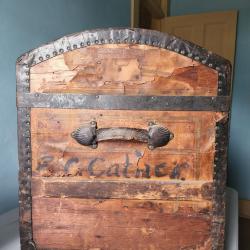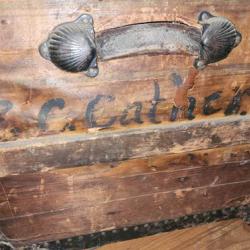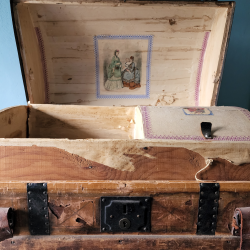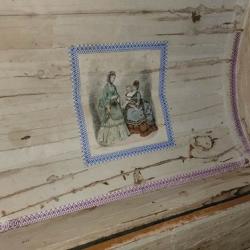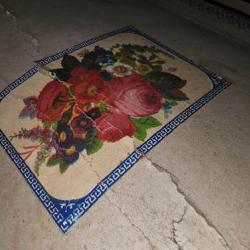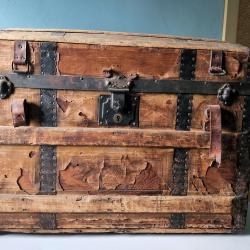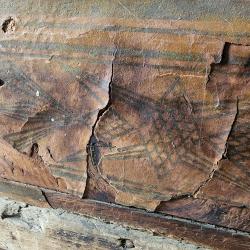Emily Caroline Cather's Trunk
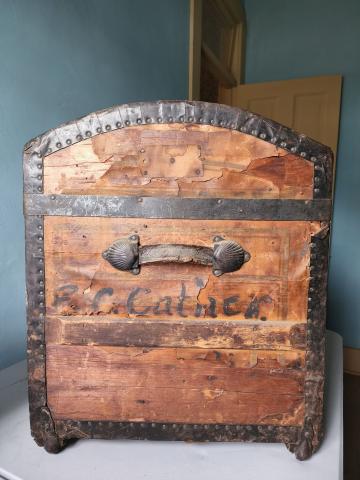
During preparation for the restoration of the Willa Cather Childhood Home, a trunk was discovered tucked away in the eaves with “E. C. Cather” painted on the side. The trunk belonged to Willa Cather’s paternal grandmother, Emily Caroline Smith Cather. The fragile piece, covered in patterned paper and with a beautifully decorated tray, was transported to the Gerald R. Ford Conservation Center for analysis in 2023. Object stabilization and preservation will cost $9,500.
The E.C. Cather trunk is an important part of the Cather family story, as it represents their migration. Like the character she inspired in My Ántonia, Emily Caroline Smith Cather moved to Nebraska from Virginia. The trunk accompanied her when she and her husband, Willa’s grandfather, moved to Webster County in 1877.
The Cather’s pioneer settlement of the Great Plains is part of a grander story of the westward movement of well-established U.S. families who sought new opportunity in the American West. The Cathers themselves had been in the United States for well over a hundred years when they migrated. In her fiction, Willa Cather alludes to similar movements of families like the Garbers in A Lost Lady, the Burdens and Miners in My Ántonia, and Dr. Archie in The Song of the Lark. Cather writes of the differences between immigrants from other countries and migrants from the U.S. The stories are different—one group generally more financially and culturally comfortable than the other. Through preservation and interpretation of this trunk, we can better explain the cross section of settlers in Nebraska and the Great Plains and their individual and collective struggles and successes.
Who was Emily Caroline Smith Cather?
Emily Caroline Smith Cather, whom Willa Cather lovingly fictionalized as Emmaline Burden, is an important character in My Ántonia as the grandmother of the novel's narrator, Jim Burden. She’s described in the novel by Jim as “apt to carry her head thrust forward in an attitude of attention, as if she were looking at something, or listening to something, far away. As I grew older, I came to believe that it was only because she was so often thinking of things that were far away.” Like Grandmother Burden in My Ántonia, Emily Caroline Smith Cather moved to Nebraska from Virginia. The trunk accompanied her when she and her husband, Willa's grandfather, moved to Webster County, Nebraska, in 1877.
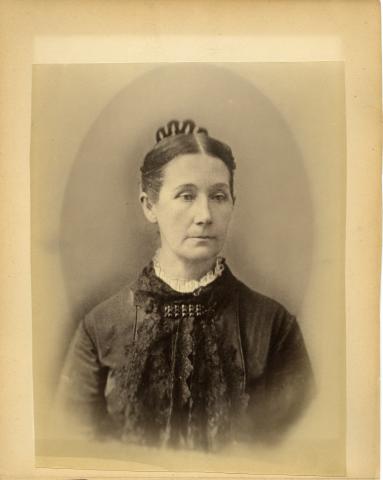
Project Relevance
Cather’s stories of immigrants from other countries, including the Czechs in My Ántonia, Germans in One of Ours, and Swedish in O Pioneers!, receive much attention, but her stories of settlers and pioneers who came from other parts of the United States are just as important in telling the story of pioneer settlement of the Great Plains and Nebraska. The Cathers themselves had been in this country for well over a hundred years when they came to Nebraska; likewise, in fiction, the Garbers in A Lost Lady, the Burdens and Miners in My Ántonia, Dr. Archie in The Song of the Lark, and more were migrants already settled in this country. These characters are portrayals of real people during Cather’s life and times who were community builders before there was a Homestead Act.
Conservation Needs
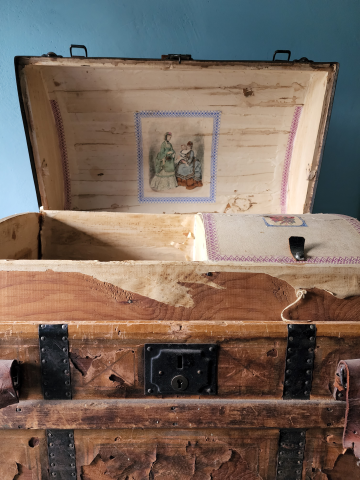
The trunk was transported in August 2023 to the Ford Conservation Center in Omaha for assessment. The object was deemed to be generally structurally sound, except for the interior tray. All materials show signs of damage from age, normal use, and exposure to unstable environmental conditions.
In order for the fragile yet precious artifact to be protected and displayed, the paper and leather on the trunk need to be stabilized to help prevent further loss of original material. The metal surfaces should also be cleaned to reduce corrosion products. A protective coating should be applied. Additional steps will need to be taken to stabilize and support the lid to display the decorative interior.
The necessary restoration and conservation of the Cather family trunk comes on the heels of the Willa Cather Foundation’s successful Campaign for the Future. In 2019, History Nebraska gifted the Foundation six Cather-related historic sites, and more than 8,000 artifacts that comprise the Willa Cather Pioneer Memorial Collection. Five historic site restorations have been completed since the transfer, including the Willa Cather Childhood Home, a $1.2 million project to ensure the site is preserved and accessible as a cultural attraction for decades to come. The Cather family trunk’s conservation was not part of this campaign, and we must raise additional funds for this important artifact.
The expert staff at the Gerald R. Ford Conservation Center have been integral partners in our prior collections conservation work, specifically assisting with the restoration of Paul Powis’ 1887 Sleigh with Trailing Wolves and the wallpaper in Cather’s attic bedroom of the Willa Cather Childhood Home.

